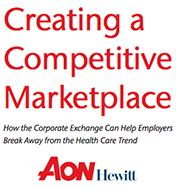Selling defined contribution health plans: benefit-cutting vouchers in “employee choice” clothes
Aon Hewitt has released some promotional material about the exchange, and one of their white-papers reads: “The control over the coverage/contribution decision transfers from the employer to the employee, and with increased control comes increased satisfaction.”
DECODING THE PITCH
A provider of “corporate exchanges” sells its defined contribution product.
According to several healthcare experts and industry insiders, however, neither company would be making this shift if they did not expect it to save them money. According to a recent survey by the Kaiser Family Foundation and the Health Research and Education Trust, annual health insurance premiums have nearly doubled over the last decade, and most of that increase has been borne by employers.
“Cutting costs is far and away the number one reason for doing this,” said Greg Scandlen, a senior fellow at the National Center for Policy Analysis, a conservative think tank. “All other considerations are secondary.”
Michael Gusmano, an associate professor of health policy and management at New York Medical College and a research scholar at the Hastings Center, a bioethics and public policy think tank, agreed, calling the claim that employers are making this shift solely because they want to offer their employees more choice “nonsense.”
“Employers face large and growing costs for health insurance and are under pressure to reduce those costs,” Gusmano said. “In that context, it seems obvious that cutting costs is the primary motivation.”
Even the advertising materials issued to promote the exchange reveal that cutting costs — not providing more options to employees — is the main incentive for employers to make the switch to a defined contribution model (see sidebar titled “Decoding the pitch”).
Shifting costs onto workers
According to Gusmano and several other experts, there is only one way that a move to a defined contribution will save employers money, and that is by shifting more of the costs of health insurance onto employees. “This is going to do nothing to slow the rise in healthcare costs,” Gusmano said, “so the only logical reason for employers to do this is so that employees will have to pay more of those costs.” (See bottom box titled “Will competition drive down costs?”)
The most likely way for that to happen is that the employer’s contribution will either be frozen at the current level or will rise at a rate that is slower than the annual increase in health insurance premiums. That rate has averaged about 7 percent over the last 10 years for family coverage, and most economists expect it to increase by at least five percent a year in the foreseeable future, despite the reforms and cost-control measures implemented as part of the Affordable Care Act.
Will competition drive down costs?
Aon Hewitt acknowledges that the primary motivation for a switch to a defined contribution model of providing health insurance to employees is to cut costs, but the company claims that the means for doing so are embedded in the structure of its exchange. The theory, explained Ken Sperling, Aon Hewitt’s national health exchange strategy leader, is that insurance companies will compete to offer employees the best value for their money, and this competition will work to drive costs down into a range that the participating companies will be willing to keep up with.
“We’ve set up a model that we believe will control costs over time,” Sperling said. The companies participating, such as Sears and Darden, “would not have moved into the exchange if there hadn’t been cost-savings involved.”
But Sterling was not able to produce any evidence that the exchange model would reduce costs without negatively impacting employees, and in interviews with a wide variety of health policy experts and economists, Remapping Debate was able to find little to back up Sperling’s claim.
“It doesn’t even have theoretical validity, much less demonstrated validity,” said Uwe Reinhardt, a professor of economics and public affairs at Princeton University who focuses on the economics of health care. Reinhardt explained that the competition between insurance companies would do little to reduce the underlying cost of health care, over which insurance companies wield only a small amount of control.
Sperling responded to that argument by saying that the exchanges would give insurance companies a greater incentive to bargain with providers over prices, thereby driving underlying costs down over time.
“On what planet does having less leverage result in better prices than having more leverage?” asked Michael Gusmano, an associate professor of health policy and management at New York Medical College. “If employers, who can offer greater volume, haven’t been able to negotiate significantly lower rates with health insurance companies, what does passing this responsibility onto individual employees accomplish? It’s nonsensical.”
Even some experts who are supportive of the switch to defined contribution told Remapping Debate that the competitive mechanisms in the exchange would do little to drive down costs. According to Greg Scandlen, a senior fellow at the National Center for Policy Analysis, a conservative think tank, the only way that the model would reduce overall health care costs is that it would force employees to get less medical care because they would not be able to afford the quantity and quality of care they currently receive.
Reinhardt agreed. “When they say ‘choice,’ what they mean is rationing,” he said.

